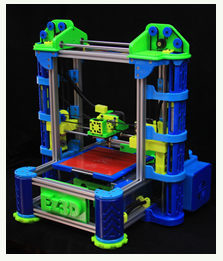EZ3D Offers Fresh Ideas for Hobbyist 3D Printing

The EZ3D printer advertises ease of use for hobbyists. Courtesy of Kickstarter.
Latest News
March 20, 2013
Being honest, a great number of hobbyist 3D printers are little more than RepRap builds that have been prettied up for consumer appeal. I’m not saying the systems are necessarily bad, but they don’t offer anything new to additive manufacturing (AM), even when compared to other home 3D printers. In theory, anyone with a fair grasp of mechanics can put together a RepRap printer. That’s kind of the point.
So, when I look at a new 3D printer, regardless of whether it’s a hobbyist model or not, I’m looking for something at least slightly innovative. A RepRap printer that glows in the dark is not innovative, it’s gimmicky (I hope I made that up). The EZ3D printer fulfills my desire for innovation by paying attention to details intended to make the 3D printing process more user friendly.
As far as specs go, the EZ3D printer doesn’t offer anything new. It has a build envelope of 8 x 8 x 9 in. (200 x 200 x 220 mm), which is decent for a home AM system, but not really outstanding. It uses 1.75 mm ABS filament and has a max resolution of around .1 mm. All of that is fine, but, at this point in the 3D printer craze, nothing to get excited about.
More interesting by far are the changes to the standard formula made by designer Jake Wood and his father Jerry Wood. The father-son team used personal experience with 3D printers to fix what they perceive as common errors in design. From the Kickstarter page:
“One day, we decided to give 3D printing a try. We thought it’d be cool. Unfortunately, what we found was a steep learning curve, unreliable printers, and an array of software that is too segmented for the average user to understand.”
“We have two words for the 3D printing industry: user experience. After building and tinkering with not one, not two, but three 3D printer models, and still not finding one with an adequate user experience, we set off to make our own.”
The first change they made was to design a more reliable mechanism for traversing the Z-axis. In place of using, as they describe it, a “screw-like mechanism,” the team built a counterweight pulley system that is intended to allow for smoother builds, particularly along the edges of a print. The Woods also implemented a cooling system for the filament to reduce jams near the extruder head.
Those mechanical improvements are interesting, but what I was most impressed with was the proprietary software designed to run the printer. The program can form a queue of prints to be built, it tracks past builds and offers a library to organize your files. It also includes a system designed to rescue builds that will fail. The last feature starts a virtual build from the top down (rather than the bottom up) and can be paused where a build started to have issues. This gives users a chance to save a build by resuming the print from the point where problems began.
I will say I’m not fond of the rainbow color scheme of the standard EZ3D printer. The machine looks more like an oversized toy than anything, but that might just be nitpicking. At around $1,500, the price is a little higher than I’d like, but it might actually be worth it if the software turns out as well as the Woods are claiming it will.
Below you’ll find a couple videos about the EZ3D. The first demonstrates the pulley system at work, and the second is a test print of the ever-popular Yoda bust.
Source: Kickstarter
Subscribe to our FREE magazine, FREE email newsletters or both!
Latest News
About the Author
John NewmanJohn Newman is a Digital Engineering contributor who focuses on 3D printing. Contact him via [email protected] and read his posts on Rapid Ready Technology.
Follow DE






